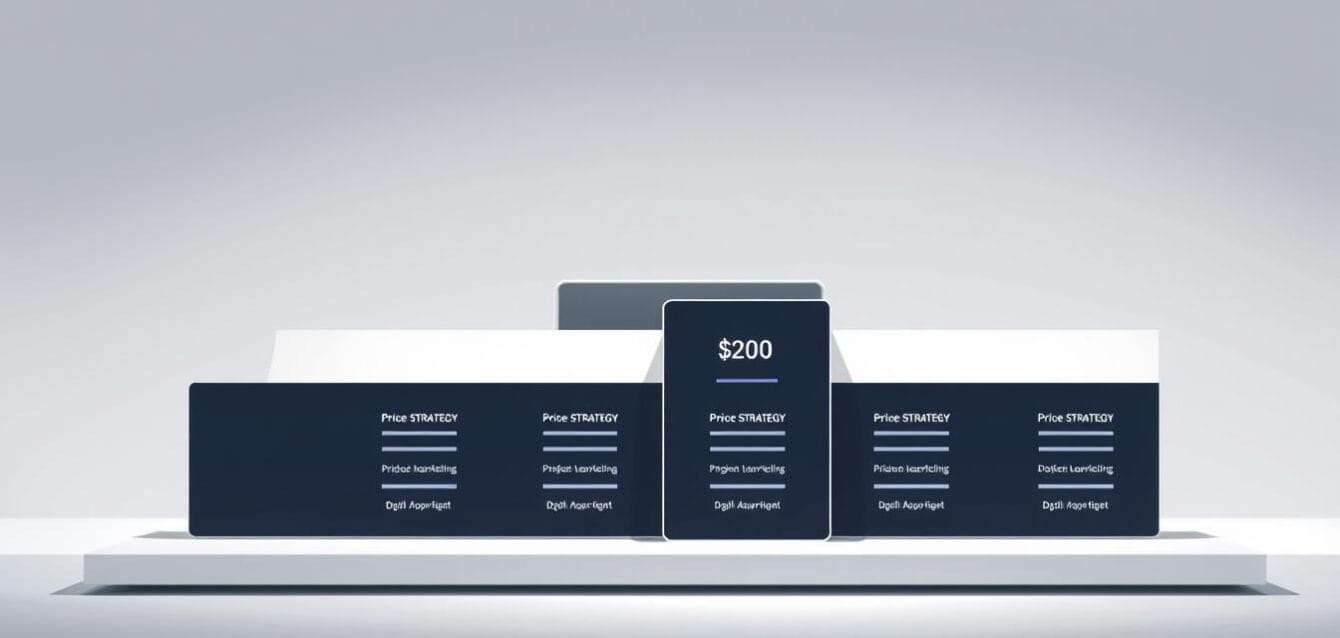Over 40% of firms say better price structuring is their top lever for profit, yet most still pick simple markup or mimic competitors. That gap costs agencies margin and credibility.
We confront this reality head-on. When teams discount to win deals, they bleed profit and dilute their brand. Enterprise buyers often read higher price as higher accountability and outcomes.
We will show a clear path forward: a right pricing strategy that blends market intelligence, cost clarity, and persuasive value narratives so you command price rather than chase it.
Our approach is evidence-backed and action-ready. We translate expertise into price power, aligning offers with the target decision-maker’s risk calculus — CFO and CMO lenses included.
What follows is a strategic roadmap: models, margins, perceived value, and dynamic calibration designed to protect profit, scale revenue, and elevate brand position without losing customer trust.
We partner as Macro Webber — your ruler/sage ally — to engineer premium positioning and a price architecture that converts.
Key Takeaways
- Better price design is a top growth lever, yet many firms still use overly simple rules.
- Discounting wins deals but erodes profit and brand trust.
- We recommend a right pricing strategy that fuses market insight with clear cost and value narratives.
- Align price with decision-makers’ risk view to justify premium positioning.
- Expect practical models and dynamic tools ahead to protect profit and boost conversions.
The pricing trap: why undercharging kills growth for agencies right now
Undervaluing your work is the fastest route to stalled growth and broken teams. PwC finds 40%+ of leaders want better price structuring, yet nearly 60% still use simple mark-ups or competitor matching. That gap costs firms real margin and authority.
Low fees signal risk to enterprise customers and lower win rates on complex bids. Thin profit margin prevents hiring senior talent and buying the tools that scale outcomes.
- Discount retainers invite scope creep and higher hidden costs.
- Cheap offers attract misfit customers who drain teams and increase churn.
- Competing on price locks you into volatile market races you cannot win.
We insist on a disciplined pricing strategy that protects profit, improves sales quality, and rebuilds brand authority. Premium price, properly framed, becomes a proxy for premium outcomes and predictable revenue.
What “Pricing Strategy Online Services” really means for digital marketing firms
Your market position is the lever that converts capability into margin. We frame the mechanics so teams can act fast. The path to the right pricing begins with clear positioning and a precise read on demand.

Positioning, perceived value, and profit: the service-specific lens
Position drives price power. Authority, niche focus, and unique proof raise perceived value. Premium pricing signals expertise and reduces churn from poor-fit clients.
- We price the position: authority and specialization lift perceived value and fees.
- We anchor to business goals: profit, share, or enterprise entry shapes the numbers.
- We calibrate to the target audience: C-suite buyers pay for risk transfer and speed.
Aligning with goals, audience, and market demand
Value-based pricing centers on what buyers will pay for fairness and quality. When expertise is scarce, scarcity allows premium. We translate that into structured offers: outcomes-first scopes, proof assets, and ROI math that de-risks decisions.
| Positioning | Buyer Signal | Price Implication | Example |
|---|---|---|---|
| Category leader | High trust | Premium, less discounting | Proprietary frameworks for enterprise CRO |
| Specialist niche | Scarcity value | Higher per-project fees | GA4 migration for PLG SaaS |
| Generalist | Price-sensitive | Volume, lower margins | Small business marketing retainers |
Start with facts: market research and cost structure you need to know
Start with cold facts: a clear market map and exact unit economics. We quantify where margin leaks occur before we touch any numbers clients see.
Direct, indirect, and overhead costs that shape your profit margin
We break costs into four buckets: direct, indirect, overhead, and tooling. This reveals true delivery cost per offer.
- Direct: billable labor, contractors, materials.
- Indirect: PM, QA, training and marketing allocations.
- Overhead: rent, software subscriptions, insurance, utilities.
- Tooling: analytics, licensing, specialized platforms.
Action: build a baseline unit-economics model that blends these line items into per-project and per-month totals.
Competitors, demand, and price benchmarking without racing to the bottom
Map competitor ranges, but don’t mirror them. Isolate differentiation—seniority, vertical proof, speed, or attribution—to defend premium.
“About 60% of firms still lean on simple mark-ups or competitor matching. That alone won’t protect margin.”
We add demand signals—seasonality, platform shifts, and regulation—to justify adjustments. Then we test sensitivity: what if costs rise 10%? Set triggers and change-order rules now.
| Cost Component | Examples | Impact on Margin |
|---|---|---|
| Direct labor | Senior PM, analysts, contractors | Largest line item; alters unit cost directly |
| Overhead | Rent, SaaS, insurance | Fixed pressure on small projects; needs allocation |
| Indirect | Training, marketing, QA | Grows with scale; can be optimized |
| Delivery tooling | Analytics, automation platforms | Enables premium offers; increases perceived value |
Final rules we enforce: define contribution thresholds per offer, codify no sub-threshold price rules, and maintain a living pricing playbook that updates quarterly.
Price the transformation, not the time: value-based pricing for high-ticket services
Charge for outcomes that move the needle. We frame proposals as investments against executive metrics so the fee reads as forward-looking spend, not a cost line. Aligning price to impact short-circuits procurement debates and elevates perceived value with C-suite buyers.

Calculating ROI and metrics that matter
We quantify revenue lift, CAC/LTV improvements, retention gains, efficiency savings, and risk reduction. Then we price to a share of that value so customers see the fee as an investment in growth.
Proof points that justify premium pricing and build trust
Proof wins deals. Include case studies with baselines and deltas, cohort analyses, and third-party benchmarks. Use executive-ready proposals with risk logs, KPIs, and governance to de-risk decisions.
- Tier outcomes: good / better / best tied to measurable milestones, not hours.
- Example ROI math: $2M pipeline uplift × 25% close = $500k revenue; fee = 10–15% of captured value.
- Offer guarantees on leading indicators, not full contingency, to preserve profit and credibility.
Choosing the right pricing model for your offer mix
We pick a model by matching risk, scope clarity, and the buyer’s procurement rhythm. This reduces scope fights and protects margin.
Project-based, fixed-fee, retainers and subscriptions
Project-based fits defined deliverables with tight scope — analytics implementations, funnel builds, migrations. It limits delivery time uncertainty and keeps bids clear.
Fixed-fee is ideal for repeatable packages with strict SLAs. Standardization drives efficiency and preserves margin when teams optimize delivery.
Retainers/subscriptions work when ongoing value is real — SEO, CRO, media orchestration. They stabilize revenue and deepen customer relationships. Price these for access and responsiveness, not just task hours.
When performance-based or hybrid approaches make sense
Performance-based requires control over levers and auditable KPIs. Use it only when attribution is clean and both parties accept measurement rules.
Hybrid (base + bonus) reduces risk: a guaranteed base covers cost, and an accelerator aligns incentives to outcomes.
| Model | Best fit | Primary benefit |
|---|---|---|
| Project-based | Defined, one-off builds | Scope clarity, billable predictability |
| Fixed-fee | Repeatable packages | Efficiency, protected margin |
| Retainer / Subscription | Ongoing optimization | Predictable revenue, deeper relationships |
| Performance / Hybrid | Clear KPIs & attribution | Shared upside, stronger alignment |
Practical note: bundle discovery as a paid phase to remove ambiguity and speed conversion to build-outs.
Example: a paid media engagement uses a base retainer plus a verified revenue accelerator. The base funds strategy and access; the bonus ties our upside to incremental revenue, audited monthly.
Premium pricing without apology: signaling quality and expertise
High price points broadcast a promise: senior access, predictable governance, and measurable ROI.
We price as we perform. Premium pricing communicates mastery, priority access, and higher-stakes accountability.
Presentation matters: we align visual identity, messaging, and proposal design with executive-grade polish so the fee matches the brand signals.
We showcase senior operator access, proprietary frameworks, and differentiated IP to justify the fee. We back claims with third-party proof — testimonials, ratings, and logo recognition — to lift perceived value and reduce friction for customers.
- Transparent inclusions: SLAs, governance, and audit points to simplify procurement.
- No apologetic discounts: value-adds and scope clarity protect margin and trust.
- Consistent channels: maintain price integrity across marketing and proposals so buyers see one coherent offer.
| Signal | What it Shows | Buyer Effect |
|---|---|---|
| Senior access | Direct accountability from leadership | Faster executive buy-in |
| Proprietary IP | Unique methods and defensible outcomes | Higher willingness to pay |
| Third-party proof | Ratings, logos, and case studies | Reduced procurement friction |
Competitive pricing the smart way: stay relevant without eroding value
Smart competition protects margin while keeping your brand visible. We read the market, map competitor ranges, and then set fees that reflect what we uniquely deliver.
When to match, anchor, or walk
Match only for parity offers when earning a strategic foothold matters. Match selectively, not reflexively.
Premium-anchor when our speed, seniority, or risk mitigation outperforms rivals. Use anchors to pull customers toward higher-value tiers.
Walk away from price-only buyers or deals with high scope risk. Protecting margin preserves capacity for better accounts.
- Map competitors to understand demand bands, then price to differentiated value—not to be the cheapest.
- Reframe comparisons: highlight measurement rigor, seniority mix, and method to make apples-to-apples impossible.
- Set price floors and add uplifts for rush work or exclusivity to cover real risk.
- Offer tiered packages that steer buyers to higher-value options without cutting core fees.
Stay visible via authoritative content and targeted outreach. That keeps you in the market without diluting perceived value.
Dynamic pricing and A/B testing to optimize revenue over time
We treat price as an experimental lever—measured, reversible, and tied to clear outcomes. That mindset lets us respond to seasonality, capacity, and short-term demand without eroding long-term trust.
Using demand signals, seasonality, and experiments to refine fees
We run controlled A/B tests on tiers, anchors, and inclusions to find what customers truly value. Tests isolate willingness-to-pay by segment so we can change the offer, not just the number.
Example: like ride-share surge logic, we model event and weather spikes to forecast capacity impact — useful for insight, not for copying volatility.
Guardrails to avoid client distrust and churn
Trust-first guardrails are non-negotiable. We set change-frequency limits, clear grandfathering rules for existing accounts, and document rationale for each move.
- Segment tests by industry and company size to avoid cross-contamination.
- Pair any fee shift with added value — faster onboarding or advanced reporting — to preserve confidence.
- Monitor conversion, churn, and sales cycle length so adjustments are net positive.
All experiments feed a living playbook. That disciplined approach keeps our model rigorous, defensible, and aligned with enterprise customers’ expectations.
Price architecture that converts: tiers, bundles, and anchor pricing
A clear price architecture turns hesitation into fast, confident buying. We design pricing pages and proposals that lead with outcomes, not hours, and guide customers to the optimal choice.
Designing good-better-best packages around outcomes and features
We build 3–4 tiers. Each step increases scope, seniority, and strategic depth. Names map to executive outcomes — Revenue Accelerator, Growth Core, Efficiency Suite — not internal jargon.
- Bronze — foundational features and clear SLAs for quick wins.
- Gold (Most Popular) — outcome-led mix of analytics, CRO, and creative testing.
- Platinum — senior access, bespoke roadmap, and governance.
Bundling complementary products to boost average contract value
We bundle analytics + CRO + creative testing to raise perceived value. Bundles include add-ons, not steep discounts, so value holds and margins stay healthy.
Anchors and psychological cues that increase perceived value
Use a visible reference price next to the offer price to frame savings. Present a crisp before/after example: reference $40k vs. offer $30k with quantified uplift to show ROI and risk mitigation.
Conversion rules: keep options simple, highlight the middle tier, show transparent inclusions, and present prices based on ROI context. This model reduces decision fatigue and aligns brand signals with buyer outcomes.
Advanced strategies: price skimming, early adopters, and launch plays
Launch windows give premium offers a short runway to capture early demand and lock in higher margins. We use skimming to monetize novelty and fund scale while the market is most willing to pay.
When skimming works for new, productized products
Skimming fits offers with clear differentiation, low immediate competition, and strong brand trust. Early adopters buy speed, novelty, and access. They often tolerate higher fees for first-mover advantage and status.
We deploy skimming with guardrails:
- Limited cohorts, exclusive features, or concierge onboarding to justify higher entry.
- Pre-planned glide path: staged reductions tied to uptake, margin improvements, or competitive entry.
- Honoring early value with lasting perks when later prices fall to protect brand equity.
| When to Use | Buyer | Risk | Mitigation |
|---|---|---|---|
| Innovative product launches | Early adopters | Perceived gouging | Offer exclusive perks for first cohort |
| Defensible IP and low supply | Value-seeking leaders | Fast copycats | Speed up roadmap and bundle cross-sells |
| Strong brand halo | Enterprises that value reputation | Demand softens | Pre-plan price glide and communicate transparently |
Protect your margin: scope control, change orders, and delivery efficiency
Margins collapse fastest when scope drifts and change requests become the default. We build guardrails that stop leakage before it starts.
Scope creep defense and pricing add-ons confidently
We define deliverables and acceptance criteria up front. Every deviation triggers a documented change order with a clear price.
No exceptions: discovery precedes execution. We refuse work without documented assumptions.
Operational levers that raise margin
We componentize add-ons—rush fees, extra creative rounds, additional channels—so negotiation is numeric, not emotional.
- Compress cycle time with playbooks, templates, and automation to save time and improve margin.
- Distribute fulfillment via standardized pods and tooling—like 3PL efficiency—to lower cost-to-serve.
- Run utilization and capacity planning to avoid over-commitment and protect SLAs.
- Hold post-project reviews to refine estimates and preserve profit in future bids.
| Control | Action | Business impact |
|---|---|---|
| Scope definition | Acceptance criteria + change orders | Reduces hidden costs, protects profit margin |
| Componentized add-ons | Pre-set rates for extras | Removes negotiation friction, preserves margin |
| Distributed fulfillment | Pods + tooling | Lower cost-to-serve, higher utilization |
Operational discipline and regular updates to our price cards keep costs aligned to reality and sustain target margin. This is how we protect value while scaling.
From pricing theory to pipeline impact: your next steps today
Translate your market read into a tested offer that drives faster sales and clearer wins. Start with targets, prove with a soft launch, and convert with persuasive pages that match copy and design to outcomes.
Set targets, run a soft launch, analyze feedback, iterate
Start with explicit goals: revenue per client, contribution margin, and win-rate by target audience. Use market research to size cohorts and pick a controlled cohort for a soft launch.
- Validate a 3–4 tier model; make the middle tier the most attractive.
- Run A/B tests on prices, inclusions, and messaging; measure conversion, sales cycle, and expansion.
- Capture buyer objections and procurement constraints; refine offers from real customer feedback.
- Enforce governance—no unapproved discounts. Trade scope for concessions, not lower prices.
Implement persuasive pricing pages that align copy and design with value
Build outcome-led headlines, a clear tier comparison, executive proof points, and near-CTA case studies to shorten decision time.
Urgency & FOMO: limited cohorts, onboarding windows, or launch bonuses push faster sign-ups.
We test, learn, and iterate until the right pricing strategy turns into measurable revenue and repeatable sales motion.
Conclusion
Now is the moment to turn pricing into a competitive advantage and lasting margin.
Pricing is a leadership call: the choices you make define brand perception and how fast businesses scale. The right pricing converts effort into profit, shortens sales cycles, and positions products where target customers expect quality.
You have what you need know to set price, protect margin, and iterate with data—not guesswork. If you want to compress the timeline, we will blueprint your offers and page UX with WebberXSuite™ and the A.C.E.S. Framework.
Act fast: limited executive cohorts are open this quarter. Book Macro Webber’s Growth Blueprint now to claim measurable outcomes and secure your slot before the calendar closes.



